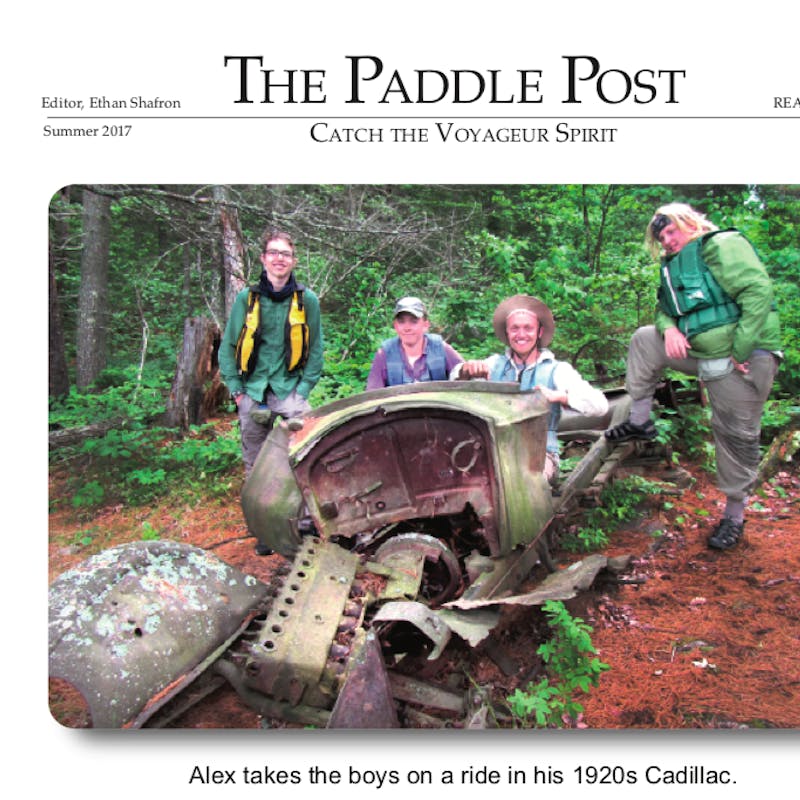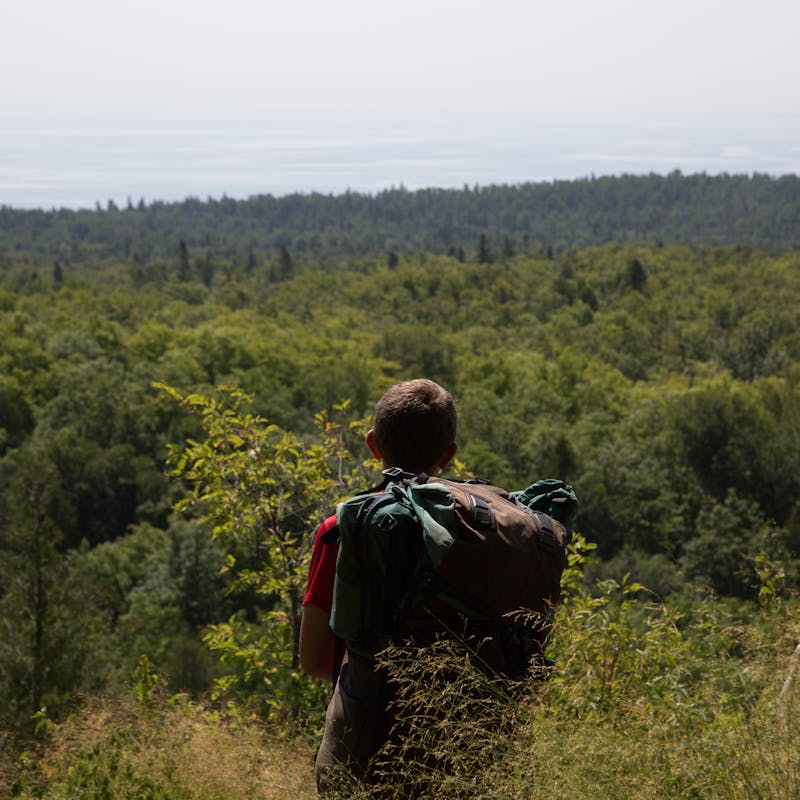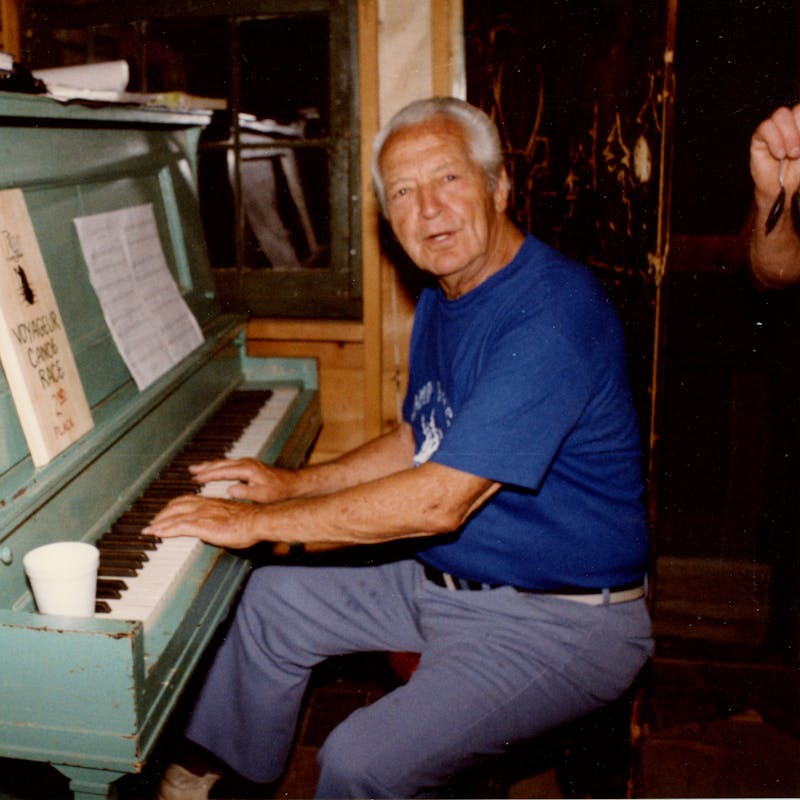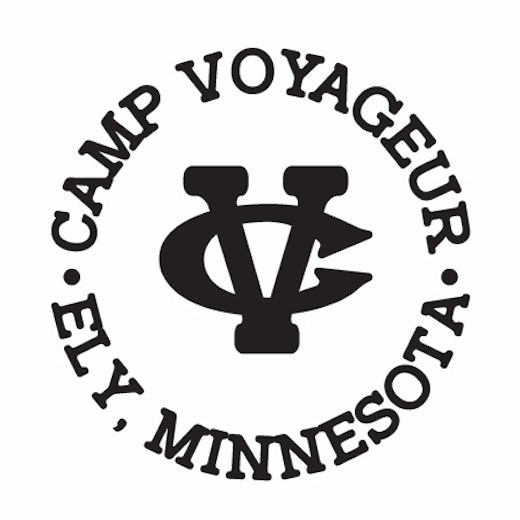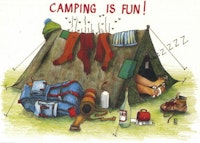
Alright parents, yes only parents; unfortunately even if you tell your children to read this they probably won’t, this will be an in-depth look at different types of gear your child will need for camp, and will likely use outside of camp. I still recommend you go over camp’s checklist, linked here. However, if you’re looking for specific recommendations, or need help choosing between different brands, then you’re in the right place!
These recommendations are based on my six years as a camper and three as a counselor, so I've been around the Boundary Waters block. My experience has included dragging canoes along coasts in freezing rain, tipping a canoe with my personal gear on multiple occasions, falling into mud up to my ears, and breaking my toe on a rock due to poor shoe selection (I probably should have seen that one coming when I purchased these "shoes").
Camping is just living in a minimalist setting, and just like normal living, there are multiple options that work. For example, I don't like wool socks because they make my feet itch, so I select my shoes to help me avoid them. I can already see the eye-rolls of my fellow counselors because this is sacrilege of the highest order. While I wouldn't recommend cotton socks (or anything cotton for that matter), consider your camper's preferences so they don't end up hating their socks and stuffing them in the pocket of a pack to be forgotten for what I can only assume is eternity.
 A few things to consider before selecting gear: How sensitive is their skin to scratchy materials? Unfortunately durable gear tends to be less comfortable. How sensitive is your camper to the sun? While campers will be reminded to put on sun-screen, as a camper, and yes, even a counselor, I have been known to overestimate how much sun I can handle. A good brimmed hat or long sleeves on breathable clothes will help your camper remain protected despite the heat or their own confidence. What kind of sleeper is your camper? Some campers can sleep on nails and wake up singing with the birds, whereas I could sleep on a bean and still struggle to get a good nights sleep. How does your camper do in colder weather? A long sleeved shirt compared to a t-shirt can make a big difference. These considerations and more all contribute to helping campers, but realistically their parents, understand what gear is going to help them the most on the trail.
A few things to consider before selecting gear: How sensitive is their skin to scratchy materials? Unfortunately durable gear tends to be less comfortable. How sensitive is your camper to the sun? While campers will be reminded to put on sun-screen, as a camper, and yes, even a counselor, I have been known to overestimate how much sun I can handle. A good brimmed hat or long sleeves on breathable clothes will help your camper remain protected despite the heat or their own confidence. What kind of sleeper is your camper? Some campers can sleep on nails and wake up singing with the birds, whereas I could sleep on a bean and still struggle to get a good nights sleep. How does your camper do in colder weather? A long sleeved shirt compared to a t-shirt can make a big difference. These considerations and more all contribute to helping campers, but realistically their parents, understand what gear is going to help them the most on the trail.
The trail is unique for gear because it has two conflicting sides. Gear that would make for the most comfortable at-campsite experience (such as: large tents, refrigerated food, the in-camp sauna) also make for the most difficult to downright impossible from a travel perspective. On the other hand, what would be easiest to travel with (a water-bottle, good clothes, and your sense of adventure) will likely leave you freezing and hungry at-campsite. The bad news is the top of the line gear thats helps you balance these two to a ridiculous extent is expensive. The good news is a significant portion of people who engage in these activities have little to no income, a la college students and yours truly. There are a wide range of solutions, so without any further adieu lets get down to the actual gear.
We'll start with the most important, and work our way down to the optional. We'll also go over what camp provides, and you as parents don't need to worry about.
Trail Shoes: Step into my office. I have tried just about every option over the years; some have worked, some have broken my toe (yes I'm still upset with toe-shoes, even though I probably should have seen that coming).
-
 Athletic shoes: often times your average pair of well-used old shoes will satisfy your needs. Don't wear anything too new, and avoid soft mesh that could tear. A good example is Aesics DynaFlyte (pictured right), but keep in mind I wouldn't buy a new shoe unless I didn't care how mangled it looked at the end of the season (which I don't but I understand people who do). The qualities I'm looking for are a sturdy shoe with good support, comfortable, about medium weight, and materials that won't tear under a little pressure. I think Aesics makes durable running shoes, but a large chunk of the market should work just fine. Just avoid extravagant shoes that are too bulky, or super-light shoes that won't last the season. Chances are your camper has an old pair that will work just fine.
Athletic shoes: often times your average pair of well-used old shoes will satisfy your needs. Don't wear anything too new, and avoid soft mesh that could tear. A good example is Aesics DynaFlyte (pictured right), but keep in mind I wouldn't buy a new shoe unless I didn't care how mangled it looked at the end of the season (which I don't but I understand people who do). The qualities I'm looking for are a sturdy shoe with good support, comfortable, about medium weight, and materials that won't tear under a little pressure. I think Aesics makes durable running shoes, but a large chunk of the market should work just fine. Just avoid extravagant shoes that are too bulky, or super-light shoes that won't last the season. Chances are your camper has an old pair that will work just fine. - Water-designed shoes: This is actually what I use. Theoretically I should be using old tennis shoes, but I just can't stand wet socks in the morning. So I compromise on ankle structure because I've got sturdy ankles, and warmth because I have good blood-flow, and I use aquatic shoes. I use this brand, but several others exist like Keens or Merrell that could do the trick. Upside is no wet socks, just wet shoes, and they will probably dry by around noon on a large lake. Downside: rocks, rocks will get in your shoes, and they offer less heat than other options. Also less support, and they offer no warmth when wet. Be warned.
- Hiking boots: upside, they wont let you down and they offer a ton of ankle support. Downside, they offer a ton of weight when they get wet (they will get and stay wet for your entire trip unless you are only hiking). We find that hiking boots usually end up exhausting our campers due to their weight, and don't offer enough additional support to merit themselves. We only recommend them for hiking trips. Unfortunately, affordable options are rare for hiking boots. Expect to spend around $150+. The Salomon Quest 4D 3 GTX comes very highly reviewed. Id recommend brands like Salomon and Merrell. If you really need help selecting, visit a local shoe or outdoor wear store. I wore a pair of hiking boots my first year, and I decided against future use because of, surprise surprise, weight. I would recommend them if ankle support is crucial, but otherwise I think there are better options.
- Verdict: 90% of campers should probably just go with athletic shoes. A good hardy pair will serve you best.
Rain gear: This is a tricky one. Rain gear will serve two functions: it should keep you dry, at least relatively, and it can keep you warm. Just like any gear it has some contradictions. You could need your rain gear in the freezing cold, but on usually when it rains it's is still quite warm. Heavy rain gear in a warm rain  can add up to some miserable portages or hikes, or even heat exhaustion, so I recommend lighter rain gear. Any rain gear will do a good job of insulating heat due to is material. It is important to have cold-weather options on the trail, but I'll cover those in a later section. I use the North Face Venture 2 (pictured right); it's lightweight, durable, and waterproof. It's also lasted me over 20 trips that gave it plenty of wear and tear. For those looking to spend money for the sake of spending it, I present Arc'teryx Beta SL. It's a little lighter, probably about as durable, and a whole lot more expensive. As a budget option I would recommend Marmot PreClip, or borrowing from a family member or friend. The PreClip is tried and proven, but when it comes to other finds, like small Amazon brands, it's best to test them first to be sure. If there is no rain in the forecast all you need is a garden hose and your camper. Remember rain can last a while on the
can add up to some miserable portages or hikes, or even heat exhaustion, so I recommend lighter rain gear. Any rain gear will do a good job of insulating heat due to is material. It is important to have cold-weather options on the trail, but I'll cover those in a later section. I use the North Face Venture 2 (pictured right); it's lightweight, durable, and waterproof. It's also lasted me over 20 trips that gave it plenty of wear and tear. For those looking to spend money for the sake of spending it, I present Arc'teryx Beta SL. It's a little lighter, probably about as durable, and a whole lot more expensive. As a budget option I would recommend Marmot PreClip, or borrowing from a family member or friend. The PreClip is tried and proven, but when it comes to other finds, like small Amazon brands, it's best to test them first to be sure. If there is no rain in the forecast all you need is a garden hose and your camper. Remember rain can last a while on the trail, so really make sure it will hold up. Who knows, he might spontaneously find the motivation to clean his room.
trail, so really make sure it will hold up. Who knows, he might spontaneously find the motivation to clean his room.
Sleeping bag: This is one of those areas that some parents tend to get wrong, sorry guys it happens to the best of us. Your concerned your camper will get cold at night, and you look for something that can keep him warm no matter the conditions. Except that camping is all about the conditions and fitting everything in a pack. I have only known one camper to be cold at night due to his sleeping bag. This nameless camper decided his sleeping bag should be a thin white bed sheet. You know, the kind that are on every bed under the blankets that actually keep you warm. Needless to say the poor nameless soul got cold. But besides him, everyone has either been a perfect temperature, or a bit too hot at night. The real problem for most campers, and then inevitably their counselors, is packing their huge sleeping bags into a pack. It's a huge hassle, and it's a great way to start the morning off terribly. I would recommend a sleeping bag rated to around 40F, and a pack size around a football. The Marmot NanoWave35 (pictured right) is a good option. 35F is plenty, especially when considering your camper will likely have warm clothes to sleep in. And it will pack up nicely, so your camper won't spend 10 minutes trying to pack it before asking for help. For budget alternatives check Amazon or surplus stores for products like Mountaintop Lightweight Envelope. From its description it sounds like it will be more than fine. I only hesitate because I've never heard of the brand. Testing stuff out is always a good option. For those who some might call "financially absurd" there is the Ghost Whisperer. Is it only slightly better? Check. Does your child really need it? No. But hey, a guy can dream.
Sleeping pad: This has a clearly wrong choice. If it doesn't inflate, chances are it's gonna be a pain to pack. I'd recommend the REI Co-op Flash (pictured below). It condenses well and will keep you camper comfortable over those pesky rocks and roots. Other similar pads will work, but  be conscious of how much space they take up when deflated. For the budget option I've got a real kicker here so strap in; $0. Camp Voyageur has some life jackets that can easily be zipped together to form a relative good sleeping pad. I've known several campers and counselors to make use of this feature. I would only warn that this technique does rely on campers keeping their life jackets dry, which isn't as hard as it sounds. Insert running gag about rich people, here's the gear I wish I had: Therm-a-rest NeoAir Xtherm. All the stuff I said before about expensive gear, but I wish I had one.
be conscious of how much space they take up when deflated. For the budget option I've got a real kicker here so strap in; $0. Camp Voyageur has some life jackets that can easily be zipped together to form a relative good sleeping pad. I've known several campers and counselors to make use of this feature. I would only warn that this technique does rely on campers keeping their life jackets dry, which isn't as hard as it sounds. Insert running gag about rich people, here's the gear I wish I had: Therm-a-rest NeoAir Xtherm. All the stuff I said before about expensive gear, but I wish I had one.
Dry sack: Despite our best efforts, packs aren't waterproof. This can be a problem, especially because canoes always have a little bit of water in them. It doesn't matter if it comes in on shoes, or spills out of a water bottle. And when it's raining, the packs don't stand a chance. The pack liners do some good, but inevitably it will fall to your campers dry sack to keep their clothes and sleeping bags dry. So you really need something good for this. Sea to Summit (pictured right). This is the best, and it's $30, 20L. If your bag fails and the weather is cruel, it can end your trip. If used right you could jump in the water with this pack and your gear would be dry. It's also good packing practice to fit your sleeping bag and clothes into this pack. If they don't fit your probably packing too much stuff. The sleeping pad isn't packed into this bag.
Water Bottle: There are options, but we recommend Nalgene. We need a lot of water on the trail, so we require two large water bottles. Also they need to be durable, because they will be on the outside of packs and slipping all around the canoe. Finally they need a big mouth so they can be filled up fast and purified fast. Don't get a bottle with a straw. Nalgene is simple and proven, and they can also be purchased at the camp store. So if they are lost, we can replace them easily. Water is really important, so if your child shows up with a Gatorade bottle some changes are going to have to be made.
Trail clothes: It's good to pick out a set of clothes that are going to be worn on the trail. Always keep in mind these are going to get wet and dirty. Your camper will be spending most of the day in them, so pick something they like, but can stand to burn after your done with them.
- Base-layer: Here is how I stay warm on the trail. I take a base-layer with me, and then I basically use it like a jacket. It rolls
 up fairly small, it's breathable, and is either synthetic or wool (notice this reoccurring material). I try to keep it dry so it can be stored inside my pack liner. But in the event of a cold day or a cold rainy day I can toss it on under my rain coat, or wear it to bed, and be snug as a bug. There are a lot of options out there, so I'm just going to use the Patagonia Capilene (pictured right) as an example, and explain why it works. It's pretty small overall, so it can be easily packed away on warm days without overflowing packs. It's also polyester, so if it gets wet it will still retain heat. And it's breathable, so on moderately cold days it will keep you just the right temperature, and on very cold days rain gear will cut off that breathing to help you retain all the heat. I would recommend brands like Patagonia, Marmot, and North Face (or The North Face, not sure which it is). If you want to spend money Arc'teryx has you covered. If your looking for a budget choice you might already have a wool jacket of some kind that will work. Another option is Goodwill, or some Amazon brands. Just look out for cotton, because once that gets wet it will stay wet and drag you down with it.
up fairly small, it's breathable, and is either synthetic or wool (notice this reoccurring material). I try to keep it dry so it can be stored inside my pack liner. But in the event of a cold day or a cold rainy day I can toss it on under my rain coat, or wear it to bed, and be snug as a bug. There are a lot of options out there, so I'm just going to use the Patagonia Capilene (pictured right) as an example, and explain why it works. It's pretty small overall, so it can be easily packed away on warm days without overflowing packs. It's also polyester, so if it gets wet it will still retain heat. And it's breathable, so on moderately cold days it will keep you just the right temperature, and on very cold days rain gear will cut off that breathing to help you retain all the heat. I would recommend brands like Patagonia, Marmot, and North Face (or The North Face, not sure which it is). If you want to spend money Arc'teryx has you covered. If your looking for a budget choice you might already have a wool jacket of some kind that will work. Another option is Goodwill, or some Amazon brands. Just look out for cotton, because once that gets wet it will stay wet and drag you down with it. - Socks: If you are going to take socks as part of your trail clothes they need to be wool or synthetic. They are 100% going to get wet every day. Get something like Smartwool. Just to reiterate, I don't wear socks, so I'm a little out of my element here. Cheap and expensive alternatives exist, and shouldn't be too hard to find. Here's some on Amazon.
- Pants: There are days when pants are good on the trail, there are days when shorts are good. For this reason I suggest zip-off pants. I actually prefer these more for the bug protection than warmth, but regardless of your reason (another good one is protection from the sun) having options are always helpful on the trail. The
 downside is you need to keep track of the pant bottoms, or you'll be left with regular shorts like a common plebeian. If you want to copy me and do exactly like I do, here are some quick dry pants on Amazon (pictured right) that look perfect to me. If you don't like greatness I can understand. Just make sure whether you buy shorts or pants they are quick-dry because they will get wet, if not soaked, on most days. And just remember that broken record: No cotton.
downside is you need to keep track of the pant bottoms, or you'll be left with regular shorts like a common plebeian. If you want to copy me and do exactly like I do, here are some quick dry pants on Amazon (pictured right) that look perfect to me. If you don't like greatness I can understand. Just make sure whether you buy shorts or pants they are quick-dry because they will get wet, if not soaked, on most days. And just remember that broken record: No cotton. - Underwear: I'm not going to go too in-depth here, but I recommend compression shorts like these. Chafing can be a hikers greatest enemy, and compression shorts are like his trusted steed. They also dry pretty quickly, which is always helpful.
Shirt: This actually isn't all that important to get right. I used a synthetic shirt I got from my high-school tennis team, not bragging but I was JV for three years running, and it worked just fine despite a few holes. I don't like to hit this dead horse, but: No Cotton. - Hat/Glasses: Shape these most around your campers needs. Do they burn faster than my cooking? (One of these days I'll learn). Get a large brimmed hat. Heck, get em a cowboy hat. That would actually be pretty fun. A sombrero might be a bit much. I personally use a pink trucker hat, and it works just fine. Just remember these are usually the first things campers lose, so I would heavily caution against those expensive sunglasses.
- Gloves: If your camper gets blisters easily you might consider a pair of paddling gloves. Paddling canoes involves a lot of palm rubbing, and blisters are a common occurrence for new campers. They can also just strategically use some duct tape, so it's up to you.
- Bandanna: Ok here it can be cotton. You don't need it, but it's kinda nice in some circumstances.
In-Camp clothes: These are campsite clothes, not In-Camp like at 709 Voyageur Rd Camp Voyageur In-camp. Again it's good to pick out a set of clothes for this specific purpose. A few things to keep in mind: These are going to be packed up, not worn, during the day, so they need to be packable. They are also worn in the morning and at night, so they need to be slightly warmer than your camper's trail pair. They should also be kept as dry as possible, excluding the inevitable slip and heavy rain once in a while, so we can relax the no cotton rule a bit.
- Dry Shoes: Yes, you need a separate pair of shoes just for in camp. In the past campers have thought to consolidate shoes, and in the past they have all been horribly wrong. One of the first things we do when we make camp is take off our wet shoes. Trench foot is a real possibility, especially when a certain counselor also thought he could sleep in his trail shoes, again nameless. There are a lot of option, but my personal choice are Crocs (pictured right). Any will do as long as they are 100% rubber. I don't know what deal with the devil that company made, but my Crocs dry faster than my feet. This is especially good because we tend to swim in our dry shoes. Some other good alternatives are Keens. Flip flops are too unreliable for activities like wood gathering, but one nameless camper actually forgot his dry shoes and made some flip flops out of duct tape (that one was me).
- Jacket: This is something your camper should only need sparingly, but it is still important to have. In the past I've used my favorite sweatshirt, yes it was cotton, and things of that nature. This year I'll be using this. I recommend you try to keep this light if possible. As long as it's not too heavy and warm enough you'll be fine.
- Socks: Ok, I just take cotton socks, because like we have established, I don't like wool socks. Your camper can take either, but just pack a pair for cold nights. Enough said.
- Underwear: Any will do, just have a pair.
- Pants: I would recommend a pair of sweat pants. They are comfy, and after a hard days travel move over cleanliness because comfyness is next to godliness. Most pants, or even shorts if your camper's confident he won't get cold, will work. Just no jeans. Seriously, never jeans, ever.
- Shirt: Just comfy, somewhat warm, not too thick so it can pack up. You can't go too wrong here.
- Hat: I recommend a nice warm beanie. It probably won't get used too often, but when it's needed it's appreciated. Any general beanie should work, but accessories like puff balls and strings just take up space without providing warmth.
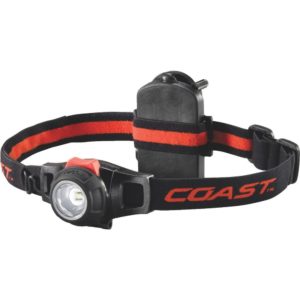
Flashlight: Your camper will need a flashlight, more specifically a headlamp. If you've ever tried to pee at night while your flashlight, it's not easy. This one is pretty highly rated (pictured left). Just be sure to test out your headlamp before camp and check what kind of batteries it takes.
Mess Kit: Your camper will need something to eat out of on the trail. As always, packable is a must, but their are also some unique requirements. First, it needs to be easily cleaned. The trail isn't the most conducive environment for cleaning, so the easier it is to clean the better chance it has at actually getting cleaned and not quietly shoved in the bottom of a pack with cheese still stuck to it. Additionally, if it's going to hold something hot, it needs to not burn your hand. I've had cool mess kits that seemed great until I tried soup. Turns out they weren't very cool. As always test them out by just using them, or pour some boiling water in them and hold them for a bit. Remember the outdoors doesn't provide tables for visitors, it's the ground or your hands. We recommend a plastic cup bowl spoon, like these.
Knife: Yes, your camper will try to convince you this is the most important gear they can get. I know I did. And I don't mind honestly. Because I'm in it for the look in a child's eye when his knife, certified for fighting bears or to survive the arctic with a flint embedded handle, gets plopped into the peanut butter jar and spread across my bagel, or slices through the veggies at night for our dinner. Honestly, counselors don't even bother checking to see if we have a knife anymore. We know there's always a camper with one attached to his belt. Has he ever needed such a rapid from-the-hip response? Nope. For our budget conscious consumers I recommend not bothering, like at all. They don't need it. For those that like to spend money, look for products with Bear Grill's name on it. That name is like a camping black hole for your knife money.
Book/Cards: I'd recommend bringing them. Despite the exhausting days, the trail can have some down time, and even the most active child will appreciate some quite reading or old-fashioned games.
Toothbrush/toothpaste: Don't forget these.
Don't Worry About: Tents, Lighters/fire-starters, Life-jackets, Paddles, Pots/pans, Food, Stoves and Maps.
Happy hunting out there. There are a lot of options, but just remember: Whats the worst that can happen really? We can probably make it work, it will be ok. Except jeans, we will leave your kid at camp if he brings jeans on the trail.
Special thanks to Outdoor Gear Lab. I would recommend parents who want more in-depth comparisons and gear reviews check their product reviews. Remember I don't actually get to test out gear, and I definitely can't afford to buy all these different brands myself, especially the really nice stuff, so I relied a lot on the reviews of others. This is a site I trust to give good information, so check it out if you need more than what I could offer, which I completely understand.
